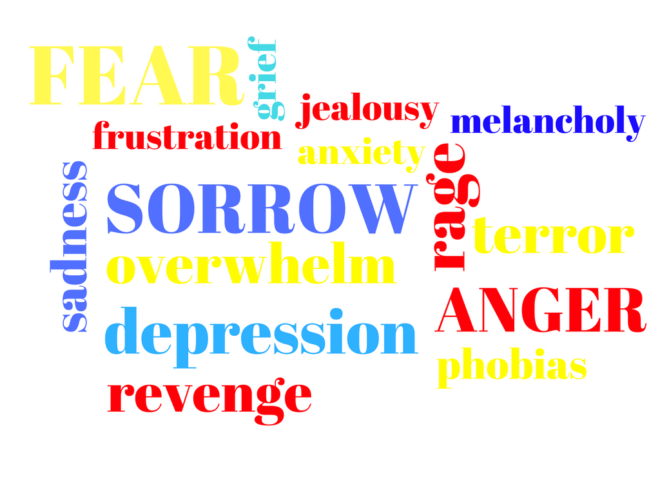I believe that all of us have 3 primary emotions that affect our lives. These emotions can be broken down further, but they can be put into 3 overriding categories:
- FEAR – anxiety, terror, phobias, overwhelm
- SORROW – melancholy, depression, grief, sadness
- ANGER – frustration, jealousy, revenge, rage
When I was thinking about how these emotions can be seen as tangible in our lives, I immediately thought of the words we use, because our words often reflect what is going on for us emotionally.
“I was so angry I saw red!” – ANGER is a primary emotion and relates to the primary colour RED.
“I am feeling blue today!” – This saying means I feel sad so another primary emotion is SORROW and it relates to the primary colour BLUE.
“He’s yellow – he ran away!” – FEAR and it relates to the last primary colour – YELLOW.
Another clue to understanding your primary emotion at any given time is simply to observe your breath (during normal activities – not during or just after playing sport, running or doing strenuous work). When you observe your breath, if you are experiencing:
- Fear – you’ll notice a shallow breath in and out;
- Sorrow – you’ll notice a long, hard, fast, breath in, and a short shallow breath out (you may also observe involuntarily sighs);
- Anger – you’ll notice a short shallow breath in, but a long, hard, fast breath out.
By paying attention to your words and your actions, you will be able to identify the emotion you are feeling and then take steps to balance it. My premise is if you balance the 3 primary emotions, you potentially can balance all the emotions.
It is possible to simply and easily balance the emotions you are feeling RIGHT NOW. This is very different to the emotions that have been trapped or blocked in your energy and physical body over time.
Identifying Your Emotion
Often it is difficult to identify the emotion you are experiencing as it could be a mixture of emotions and you don’t know which one is more dominant. If you can’t identify your primary emotion, the following tips will help you.
Start by asking yourself “What colour am I relating to – red, blue or yellow?”
Rather than trying to identify and name your feeling, use the colour to give you an insight into your root emotion. Sometimes you will be feeling different emotions at the same time, but one will be the root or primary emotion. This is the one to balance first.
If you can’t determine a colour, observe your breath. This action will also help you identify the emotion you are currently dealing with.
It is a good idea to start to keep a journal of your observations about your emotions for at least a week so that you can become familiar with your own breath.
Balance Your Immediate Emotion
Below is a simple exercise to help you to balance your emotions with your breath. This is a simple technique that can be done at any time:
- To perform this simple technique it’s best to be sitting comfortably either in a meditation pose or on a chair with your feet flat on the floor.
- Become conscious of your breath. Focus on a point at the front of your nose and your top lip.
- While doing this:-
- to the count of 10, breathe steadily in filling your entire lungs; and
- to the count of 10, steadily release the breath all the way out, completely emptying your lungs
- Continue this process for 5 minutes.
This simple breathing technique will balance your emotions. With practice, you will manage out of control emotional outbursts calmly, and effectively deal with day to day challenges.
By practicing this technique each day for five minutes you will transform every area of your life for the better.
Longer Term Solutions
If you want to go further into balancing your emotions in the long term, I recommend one (or more) of the following exercises.
Write A Letter
Writing is an exceptionally powerful way of releasing your emotions. Take some time to handwrite a letter to the person whose actions initiated your emotional turmoil.
Write as fast as you can and for as long as the words will flow. Write until there is no emotion left around this situation.
While it is tempting to type out your letter, take the time to actually hand write it. This will help you connect with a different part of your brain and to better connect with your emotions.
When you have finished with the letter, burn it. DO NOT send it. Burning it is an important part of relieving yourself of the destructive trapped emotion.
You can even hold a ceremony for the burning of it. Light some candles and say a prayer and remember to keep in mind your intention to release the emotion to the universe.
Keep An Emotion Journal
Write down (again, handwrite) how you are feeling and what you have learnt from experiencing different emotions. The important part of having this journal is to reflect on what you have learnt.
It is interesting what you will discover about yourself during this process. Often by re-reading what you have written you will discover patterns that you didn’t even know existed. Being aware of these patterns is the first step towards breaking them and releasing this emotion.
Talk To A Confidante
The meaning of confidante is a person to whom secrets are confided or with whom private matters and problems are discussed.
Find a confidante who doesn’t mix with you socially, so is not involved with the people and circumstances. Not only will they be able to see things objectively, there is no way that they can betray your trust in a social situation.
The most important job of the confidante is to listen and not try and fix the problem. We all have the solutions to our own problems within us, and the job of the confidante is to help us find our way to these solutions. Talking with a confidante will give you this space.
While it may be tempting to verbally dump all of your emotions and thoughts onto this person and then walk away because you feel better, try not to do this.
Ensure the intention of the conversation is to discover the higher learning in your experience. This will help to grow your self-understanding at a rapid rate.
Talk With A Therapist
For some people, a therapist will be the best solution for them. Choose a therapist who is skilled at releasing emotions, and one that you feel comfortable with. You could choose to have a one off session or space your sessions out if you feel you need more than one.
Choosing to speak with a therapist gives you peace of mind that you are speaking with someone who is objective about the situation and is committed to helping you to release these emotions.
Summing It Up
When you are feeling emotionally unbalanced, start by identifying exactly what the emotion is, either through colour or your breath. Once you have done this, perform the simple breathing exercise above to initially calm yourself down, then take some time to think about a longer term solution that works for you.
Why It Is Important
Our emotional health is integral in our overall health and we cannot exist long term in an emotional state of turmoil. You will find that when your emotions are balanced you will feel better, make better decisions and generally be healthier. Here’s to your good (emotional) health!
You can find much more information on living a holistic lifestyle in these free magazines and on our YouTube channel.
 Julie Lewin – Medical Intuitive
Julie Lewin – Medical Intuitive






